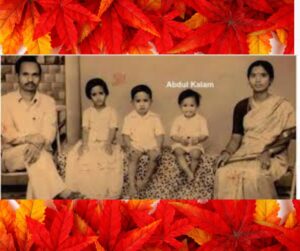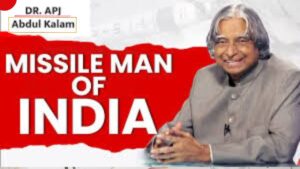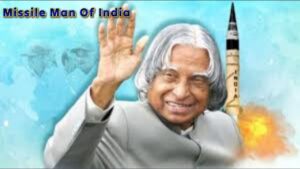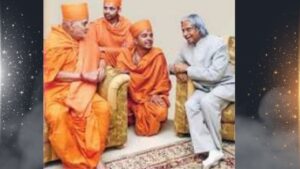A. P. J. Abdul Kalam
Avul Pakir Jainulabdeen Abdul Kalam BR (15 October 1931 – 27 July 2015) was an Indian aerospace scientist and politician. Kalam became the 11th President of India in 2002 and served until 2007. Born into a Muslim family in Rameswaram, Tamil Nadu, he studied physics and aerospace engineering. Kalam worked as a scientist and science administrator for four decades.
Kalam worked in the Defence Research and Development Organisation (DRDO) and the Indian Space Research Organisation (ISRO). He also played a key role in India’s civilian space programme and military missile development. He is known as the Missile Man of India as he played a key role in the development of ballistic missile and launch vehicle technology. Kalam played a key organisational, technical and political role in India’s Pokhran-II nuclear tests in 1998, the first tests since the original 1974 nuclear tests.
Kalam was elected as the 11th President of India in 2002 with the support of both the Bharatiya Janata Party and the opposition National Congress Party. He was awarded India’s highest civilian award, the Bharat Ratna. Apart from this, Kalam was also awarded many prestigious awards. Kalam died on 27 July 2015 at the age of 83 after fainting due to cardiac arrest.
Abdul Kalam Early life

Avul Pakir Jainulabdeen Abdul Kalam was born on 15 October 1931 to a Muslim family in Rameswaram, Tamil Nadu, which was in the Madras Presidency in 1931 but is now in the state of Tamil Nadu. His father Jainulabdeen Marakayar was the owner of a boat that carried Hindu pilgrims between Rameswaram and the deserted Dhanushkodi. Kalam’s father was also the imam of a local mosque. His mother was Ashiamma, a housewife.
Kalam was the youngest of four brothers and a sister in his family. At the time of Kalam’s birth, his family’s financial situation was poor, due to which Kalam had to sell newspapers to contribute to his family’s meager income.
Personal life:-

Kalam was the youngest of five siblings. The eldest of them was a sister, Asim Zohra (died 1997). The three elder brothers were: Mohammed Muthu Meera Lebbai Maraikayar (5 November 1916 – 7 March 2021), Mustafa Kalam (died 1999) and Kasim Mohammed (died 1995). Kalam himself remained a lifelong bachelor.
Kalam never owned a television. Kalam was in the habit of waking up at 6:30 or 7 a.m. and falling asleep by 2 a.m. His few personal possessions included his books, his veena, a few items of clothing, a CD player, and a laptop; at the time of his death, he left no will and his estate passed to his eldest brother, who survived him.
Education

Kalam was an average student in his childhood and his grades were average. But Kalam was a bright and hardworking student and had a strong desire to learn. He spent most of his time on mathematics. He completed his education from Schwartz Higher Secondary School in Ramanathapuram. A. P. J. Abdul Kalam then moved to St. Joseph’s College in Tiruchirappalli, from where he graduated in physics in 1954.
He moved to Madras to study aerospace engineering at Madras Institute of Technology. While Kalam was working on a senior class project, his dean, dissatisfied with his lack of progress, threatened to cancel his scholarship if he did not complete the project within the next three days. Kalam completed the project within the same deadline. This impressed the Dean who later told him, “I was putting you under stress and asking you to meet a tough deadline.” Kalam could not fulfill his dream of becoming a fighter pilot as he finished ninth in the qualifiers and there were only eight vacancies in the Indian Air Force.
Career as a scientist

After graduating from the Madras Institute of Technology in 1960, Kalam became a member of the Defence Research and Development Services (DRDS) and then joined the Aeronautical Development Establishment of the Defence Research and Development Organisation as a scientist. Kalam’s career began by designing small hovercraft. But he was not happy with his choice of job at DRDO. Kalam joined INCOSPAR, working under renowned space scientist Vikram Sarabhai. Kalam was recruited to ISRO by H. G. S. Murthy. H. G. S. Murthy was the first director of the Thumba Equatorial Rocket Launching Station (TERLS). In 1969, Kalam joined the Indian Space Research Organisation (ISRO), where he worked on India’s first Satellite Launch Vehicle (SLV-III). Kalam first started working on an expandable rocket project independently at DRDO in 1965. In 1969, Kalam got more engineers on board after he received government approval.
In 1963 to 1964, he visited NASA’s Langley Research Center in Hampton, Virginia; Goddard Space Flight Center in Greenbelt, Maryland; and Wallops Flight Facility. Between the 1970s and 1990s, Kalam developed the Polar Satellite Launch Vehicle (PSLV) and SLV-III projects, both of which proved successful.
Presidency:-
Kalam served as the 11th President of India, succeeding K.R. Narayanan. His term lasted from 25 July 2002 to 25 July 2007
On 10 June 2002, the ruling National Democratic Alliance nominated Kalam for the presidency, supported by the then opposition Samajwadi Party and the Nationalist Congress Party. Kalam filed his nomination on 18 June along with Vajpayee and his senior cabinet colleagues.Voting for Parliament and State Assemblies began on 15 July 2002. Counting took place on 18 July. Kalam won easily and became the 11th President of India. Kalam took oath on 25 July. Kalam became the third President of India who was awarded Bharat Ratna before becoming President. Apart from him, Radhakrishnan (1954) and Zakir Hussain (1963) received Bharat Ratna and later became President of India. Kalam was the first scientist and the first bachelor to live in Rashtrapati Bhavan.
Death:-
On 27 July 2015, Kalam went to Shillong to deliver a lecture on “Creating a Livable Planet Earth” at the Indian Institute of Management Shillong. There, he suffered a slight physical discomfort while climbing the stairs, but after resting for a while, he went to the auditorium. At around 6:35 pm IST, five minutes into his lecture, he fainted. As his condition worsened, he was rushed to the nearby Bethany Hospital. On reaching the hospital, he had no other signs of life. Kalam was confirmed dead at 7:45 pm due to sudden cardiac arrest.
Memorial:-
The Dr. A.P.J. Abdul Kalam National Memorial was built in memory of Kalam by the DRDO at Pei Karumbu in the island town of Rameswaram in Tamil Nadu. It was inaugurated by Narendra Modi in July 2017. Replica of rockets and missiles are on display. There is a statue of Kalam at the entrance showing him playing the veena. There are two other smaller statues of the leader in sitting and standing poses.
Religious and spiritual views:-
He made his spiritual journey the subject of his last book, Transcendence: My Spiritual Experience with Pramukh Swamiji.
Pramukh Swami as Guru:-

Kalam is a Hindu guru of the BAPS Swaminarayan sect. He met Pramukh Swami, whom Kalam came to consider his last spiritual teacher and guru. Kalam and Pramukh Swami met only eight times in fourteen years. The first meeting took place on 30 June 2001 in New Delhi.